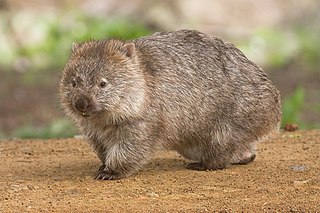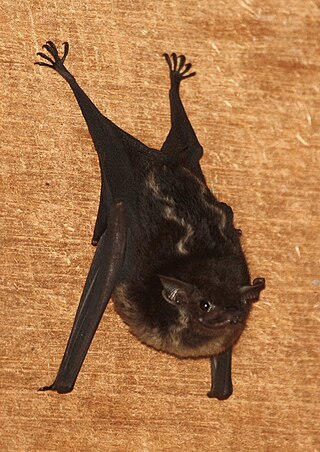
The koala, sometimes called the koala bear, is an arboreal herbivorous marsupial native to Australia. It is the only extant representative of the family Phascolarctidae and its closest living relatives are the wombats. The koala is found in coastal areas of the mainland's eastern and southern regions, inhabiting Queensland, New South Wales, Victoria, and South Australia. It is easily recognisable by its stout, tailless body and large head with round, fluffy ears and large, dark nose. The koala has a body length of 60–85 cm (24–33 in) and weighs 4–15 kg (9–33 lb). Fur colour ranges from silver grey to chocolate brown. Koalas from the northern populations are typically smaller and lighter in colour than their counterparts further south. These populations possibly are separate subspecies, but this is disputed.

Marsupials are a diverse group of mammals belonging to the infraclass Marsupialia. They are primarily found in Australasia, Wallacea, and the Americas. One of the defining features of marsupials is their unique reproductive strategy, where the young are born in a relatively undeveloped state and then nurtured within a pouch.

Wombats are short-legged, muscular quadrupedal marsupials of the family Vombatidae that are native to Australia. Living species are about 1 m (40 in) in length with small, stubby tails and weigh between 20 and 35 kg. They are adaptable and habitat tolerant, and are found in forested, mountainous, and heathland areas of southern and eastern Australia, including Tasmania, as well as an isolated patch of about 300 ha in Epping Forest National Park in central Queensland.

Moles are small mammals adapted to a subterranean lifestyle. They have cylindrical bodies, velvety fur, very small, inconspicuous eyes and ears, reduced hindlimbs, and short, powerful forelimbs with large paws adapted for digging.

Echidnas, sometimes known as spiny anteaters, are quill-covered monotremes belonging to the family Tachyglossidae, living in Australia and New Guinea. The four extant species of echidnas and the platypus are the only living mammals that lay eggs and the only surviving members of the order Monotremata. The diet of some species consists of ants and termites, but they are not closely related to the American true anteaters or to hedgehogs. Their young are called puggles.
Epping Forest is a national park in Queensland, Australia, 855 km northwest of Brisbane. The park is a scientific national park so it is not open to the public. Only scientists, rangers and volunteers may visit the park. The park lies within the Brigalow Belt North bioregion. It is within the Drummond Basin geological basin and the Belyando River water catchment area. The park was established to protect a species of wombat, the northern hairy-nosed wombat that is the world’s largest burrowing herbivore.

The Vombatiformes are one of the three suborders of the large marsupial order Diprotodontia. Seven of the nine known families within this suborder are extinct; only the families Phascolarctidae, with the koala, and Vombatidae, with three extant species of wombat, survive.

The northern brown bandicoot, a marsupial species, is a bandicoot found only on the northern and eastern coasts of Australia and nearby islands, mainly Papua New Guinea. It is not, however, found far inland.

The northern hairy-nosed wombat or yaminon is one of three extant species of Australian marsupials known as wombats. It is one of the rarest land mammals in the world and is critically endangered. Its historical range extended across New South Wales, Victoria, and Queensland as recently as 100 years ago, but it is now restricted to one place, a 3 km2 (1.2 sq mi) range within the 32 km2 (12 sq mi) Epping Forest National Park in Queensland. With the species threatened by wild dogs, the Queensland Government built a 20-kilometre (12 mi)-long predator-proof fence around all wombat habitat at Epping Forest National Park in 2002.

The common wombat, also known as the coarse-haired wombat or bare-nosed wombat, is a marsupial, one of three extant species of wombats and the only one in the genus Vombatus. The common wombat grows to an average of 98 cm (39 in) long and a weight of 26 kg (57 lb).

The greater sac-winged bat is a bat of the family Emballonuridae native to Central and South America.

The boodie, also known as the burrowing bettong or Lesueur's rat-kangaroo, is a small, furry, rat-like mammal native to Australia. Once common throughout the continent, it is now restricted to a few coastal islands. A member of the rat-kangaroo family (Potoroidae), it lives in burrows and is active at night when it forages for fungi, roots, and other plant matter. It is about the size of a rabbit and, like most marsupials, carries its young in a pouch.

The southern marsupial mole, also known as the itjaritjari or itjari-itjari, is a mole-like marsupial found in the western central deserts of Australia. It is extremely adapted to a burrowing way of life. It has large, shovel-like forepaws and silky fur, which helps it move easily. It also lacks complete eyes as it has little need for them. It feeds on earthworms and larvae.

Phascolonus is an extinct genus of giant wombat known from the Pliocene and Pleistocene of Australia. There is only a single known species, Phascolonus gigas, the largest wombat ever known to have existed, estimated to weigh as much as 200 kg or 360 kg (790 lb). It was described by Richard Owen in 1859. Phascolomys magnus is a probable junior synonym. P. gigas is distinguished from other wombats by its strap-shaped upper incisors. The cranial roof is noticeably inwardly depressed. The species was abundant across Australia, with remains having been found in all states except Western Australia. It is suggested to have had a preference for arid and semi-arid inland habitats, with a diet consisting of a high amount of low quality vegetation. Though it likely had wide home-ranges, it probably did not stray far from fresh water sources. Abundant remains have been found in Pleistocene aged deposits from Lake Callabonna in South Australia. Unlike its living relatives, it is unlikely that Phascolonus engaged in burrowing. Phascolonus disappeared during the Late Pleistocene Quaternary extinction event around 50-40,000 years ago, together with many other large Australian animals, following the arrival of humans to the Australian continent. Phylogenetic analysis suggests that is closely related to the other giant wombat genera Ramsayia and Sedophascolomys.

Lasiorhinus is the genus containing the two extant hairy-nosed wombats, which are found in Australia. The southern hairy-nosed wombat is found in some of the semiarid to arid regions belt from New South Wales southwest to the South Australia-Western Australia border. The IUCN categorises it as Near Threatened. Conversely, the northern hairy-nosed wombat is categorised as Critically Endangered and only survives in a 3-square-kilometre (1.2 sq mi) range within the Epping Forest National Park in Queensland, but formerly also existed in Victoria and New South Wales.
Brookfield Conservation Park is a conservation park located in South Australia, about 130 km northeast of Adelaide.

















